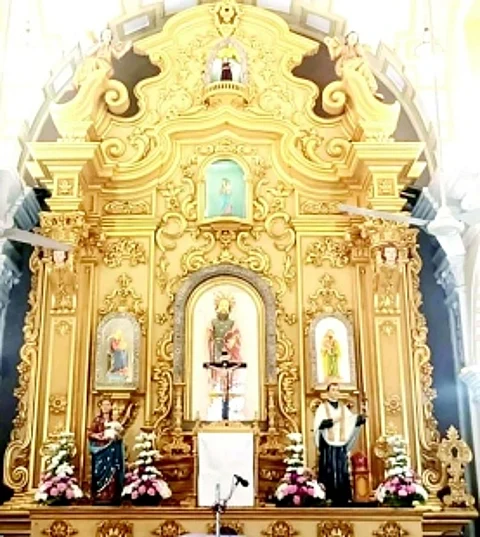

St Joaquim was the ever-chaste husband of St Anne, the mother of Mother Mary. Though advanced in years, St Joaquim and St Anne remained fervent in their prayers to be blessed with a child. God was pleased with their devotion and chose to bless them with a miraculous conception, long past child-bearing years, as a result of their love of Him and love of each other.
Tradition teaches that while Joaquim was away from home, an angel of God appeared to him in a vision. This angel promised that he and St Anne would bear a child, who would be blessed through the ages. Upon waking from this vision, St Joachim rushed home to share his excitement with his beloved wife. She was there to greet him, only to reveal the same good tidings as she was promised in another visitation from God’s messenger. Images of St Joaquim are often identified by the presence of his associated symbols. A book or scroll represents linen makers, a shepherd’s staff for the Christian word, and a basket of doves represents peace. He is almost always dressed in green, which is the color for hope.
Both, portraits and narrative images usually represent St Joaquim as a man in later middle age, with a forked beard, usually grey, that reaches to about the breastbone. He often carries a staff, referencing his journey into the mountains. In some images, there will also be a lamb or sheep, referring either to his rejected offering or to the flocks he took into the mountains.
On August 1, 1879, the Sovereign Pontiff Leo XIII, who received the name of Joachim in Baptism, raised both the Feast of his glorious patron and that of St Anne to the rank of double of the second class. In Goa, the devotion to St Joaquim is not as huge. Statues of him are very rare as independent standing images. However, occasionally one may see ensembles composed of the saint shown standing besides his wife St Anne, accompanying his daughter Mary.
There is only one Catholic edifice dedicated to St Joaquim. This chapel is situated in Borda, Margao. Permission to construct this chapel was granted on October 9, 1783, after a large number of residents from Rachol shifted here. The Chapel was built in 1786 and consecrated on August 20 in the same year. The chapel annually celebrates its patron on the third Sunday of August with the feast traditionally being known for guavas.
Locally it was referred to as ‘Perãchem Fest’ or ‘Festa das goiabas’. The chapel boasts of Goa’s renowned personality’s i.e. Dr José Pereira’s fresco completed during the end of the 20th Century. “Besides the religious significance of the feast, I go to buy garden equipment from the feast fare. Local ‘Kamaar’ (blacksmiths) get for sale various locally made tools like sickles (viddo/kantul), Koiti, Horem (spade), pikas (pickaxe), paroi, etc. My family always enjoys having the typical Goan ladoos and kaddio-boddio from the sweet vendors,” says Sameena Faleiro from Borda, Margão. Many couples looking for the gift of a child come here to seek blessings of St Joaquim.
“As we celebrate ‘Perãchem Fest’ this year with ‘Ekcharan paulam marum-ia, xubvortomanache porgotnad zaum-ia’ as the theme, for us ‘Bodekars’, this is not simply a feast but an emotion and an opportunity to grow and improvise,” says Darwin Fernandes from Borda. Further, he mentions that just like many places across Goa celebrate August 15, which is the day of the Feast of Our Lady Assumption, as their harvest feast, here in Borda residents celebrate one of the famous local fruits i.e the guava, which one would find in abundance during this season.
Traditionally guavas were blessed here during the High Mass and later distributed among the faithful. Guavas were also sold outside the chapel. In the good old days, after the High Mass, there would be a procession led by the celebrant priest, holding an image of St Joaquim, accompanied by a brass band. However, today this procession is no longer held due to excessive traffic on the road outside the Chapel. The Confraria de Deus Espírito Santo e Santíssimo Sacramento of the Holy Spirit Church would be an integral part of this procession. It is noteworthy that traditionally, the brass band would play before the Novena, on all the nine days. However, in today’s times one can hear it only on the occasion of the vespers and the feast.
“Now, guavas are not blessed like how they used to be in the bygone era,” says Darwin. But many locals still donate/distribute guavas during the feast. “As per stories passed down from generation to generation, the local community of Borda would offer guavas during this feast seeking blessings on their cultivation,” says Darwin.
‘Traditionally the fair was limited only to roasted gram, guavas, sweet vendors and blacksmiths,” says Florina Almeida from Borda. Further, she mentions that these vendors would remain for a week after the Feast while today, they are seen only for about two days after the Feast.
‘In my ward, ie Marlem, annually on the day of the Feast, boys would come out to play a game called ‘Mittanni’ at 2 pm after lunch. Somewhere about at the same time, outside the chapel, there was another interesting game being played, where blindfolded men had to break open a de-husked coconut, using a solid bamboo. Each player had three chances,” recalls Florina. Sadly, these traditional games are no longer played. Today, a sports event is held on a larger scale on the Multipurpose ground at 3 pm.
The niche of St Joaquim was heavily decorated only with locally grown white fragrant flowers called Zuio, which filled the whole chapel with their mild pleasant fragrance. This year, the Feast will be celebrated on August 18 with the Feast Mass at 9 am. The main celebrant for the High Mass will be the Auxiliary Bishop of Goa and Daman, Fr Simião Purificação Fernandes.